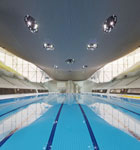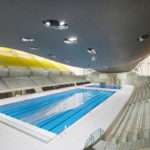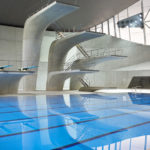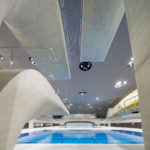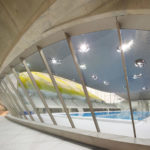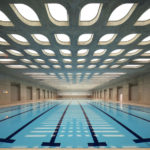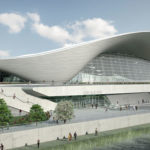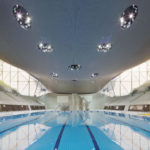
Zaha Hadid is the highly public Iraqi-British architect behind the London Aquatics Center. Photo: Simone Cecchetti.
When Zaha Hadid Architects received the RFP for the London Aquatics Center, one thing stood out: the emphasis on sustainability. The 2012 Olympic Committee wanted this year’s Summer Olympics to be the greenest games in history. It planned to use pre-existing venues where possible and build only structures that would serve long-term uses. It would use biofuel in the park’s boiler system and use a combined-heating-and-cooling system that recycles heat exhaust.
In accordance with this vision, the world-renowned Iraqi-British architect and her team designed the London Aquatics Center as a shrinking building, one that will eventually be scaled back to a “legacy” version of its Olympic glory, transitioning from one of the largest Olympic venues in history, by capacity, to the smallest.
The aquatics facility, which will host the swimming, diving, and water polo events, includes a 50-meter competition pool, a 25-meter dive pool, and a 50-meter training pool. During the upcoming Summer Olympics, it will seat 17,500, but only 2,500 of those seats will remain after the competition. The “wings” on either side of the structure will be dismantled, leaving only the central form. What will happen to the excess material? It will be resold or recycled.

The competition pool is the typical 50 meters. Above it rolls the roof like a giant wave, its slats made from FSC-certified red lauro wood, which is highly durable and moisture resistant. Photo: Hufton + Crowe.

Fluidity was a key design element for Zaha Hadid and her team, seen here in the shape of the concrete diving platforms, curving up from the floor. A lot of concrete was used, but the architects used a most sustainable cement replacement for much for it. Photo: Hufton + Crowe.
The 650-foot-long building is just big enough to hold the necessary functions and no bigger. “Why build an enormous venue which cannot be maintained, as opposed to having an adaptable, smaller building which can be used by the local community in a much more sustainable way?” Zaha Hadid says. “I was intrigued by the task of having to design a flexible building suitable for the Olympics as well as to the generations of Londoners who will use the pools long after the Games are over.”
One of the aquatics center’s greenest features is its concrete, which is good because there’s a lot of it. It supports the undulating roof with giant columns and also forms the monolithic diving platforms. In terms of its green properties, nearly 75 percent of the cement used for the concrete mix of the substructure as well as 40 percent of the superstructure have been replaced with ground granulated blast-furnace slag (GGBS), a byproduct of furnaces used to make iron.

This rendering shows the Aquatics Center in "Legacy Mode," the language for the post-Games structure, without its wings of 12,000 seats.

This elevation shows the building's extra wings, which will be shed after the Olympic games in order to transform into a right-sized swimming facility for the neighborhood.

This view shows the volume of the space that will be removed. In all, nearly 12,000 seats and other building materials will be resold or recycled.
GGBS concrete is a sand and gravel aggregate, which emits substantially less carbon dioxide than cement. “A lot of research and trials were necessary to figure out how to deal with the sustainable concrete mix,” project architect Sara Klomps says. “It contained a high percentage of cement replacement and recycled and secondary aggregates. It proved to be much more difficult to work with than ordinary concrete, but it turned out, … and we’re really proud of the high replacement results.” (Read gb&d‘s Q&A with Sara Klomps.)
Designed in a wave-like shape to represent the fluidity of water, the underneath of the aquatic center’s distinctive roof is FSC-certified red lauro wood from Brazil. This exotic wood was chosen because it provides teak-like durability in high-moisture areas. Laminated softwood cladding was used for the building’s interior spaces. The roof exterior is a highly durable and mostly recycled aluminum cladding. The facility also recycles waste heat from two nearby energy centers and reuses pool water for non-potable functions.
Though many of the London Aquatics Center’s environmentally conscious elements can be listed and lauded—and rightly so—the building will only truly prove itself after the conclusion of the 2012 Summer Olympic Games, when it sheds its extra seats in order to serve not the global community but the local one.
- The competition pool is the typical 50 meters. Above it rolls the roof like a giant wave, its slats made from FSC-certified red lauro wood, which is highly durable and moisture resistant.
- Fluidity was a key design element for Zaha Hadid and her team, seen here in the shape of the concrete diving platforms, curving up from the floor. A lot of concrete was used, but the architects used a most sustainable cement replacement for much for it.
- This rendering shows the Aquatics Center in “Legacy Mode,” the language for the post-Games structure, without its wings of 12,000 seats.
- This elevation shows the building’s extra wings, which will be shed after the Olympic games in order to transform into a right-sized swimming facility for the neighborhood.
- This view shows the volume of the space that will be removed. In all, nearly 12,000 seats and other building materials will be resold or recycled.
- Zaha Hadid is the highly public Iraqi-British architect behind the London Aquatics Center. Photo: Simone Cecchetti.

